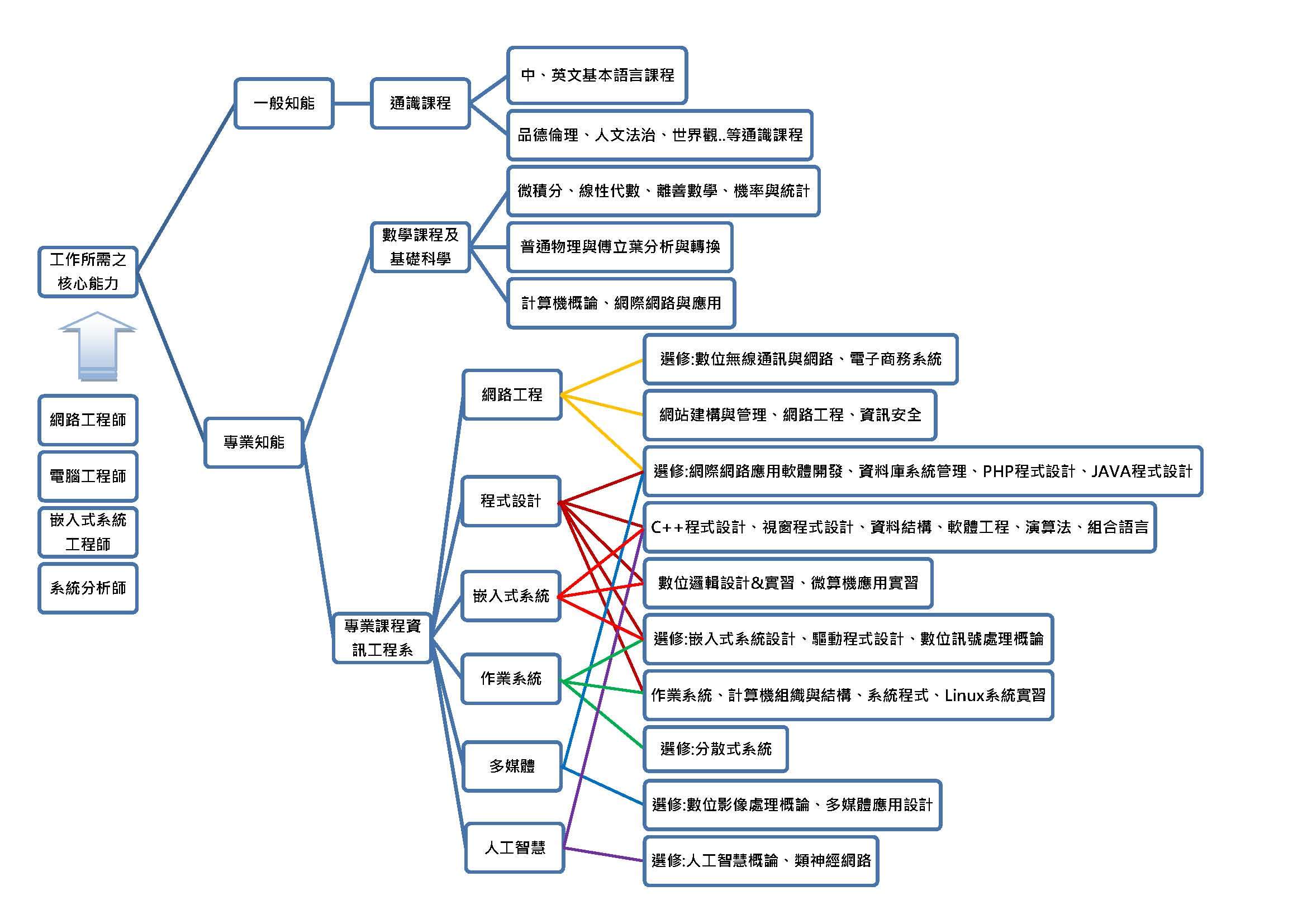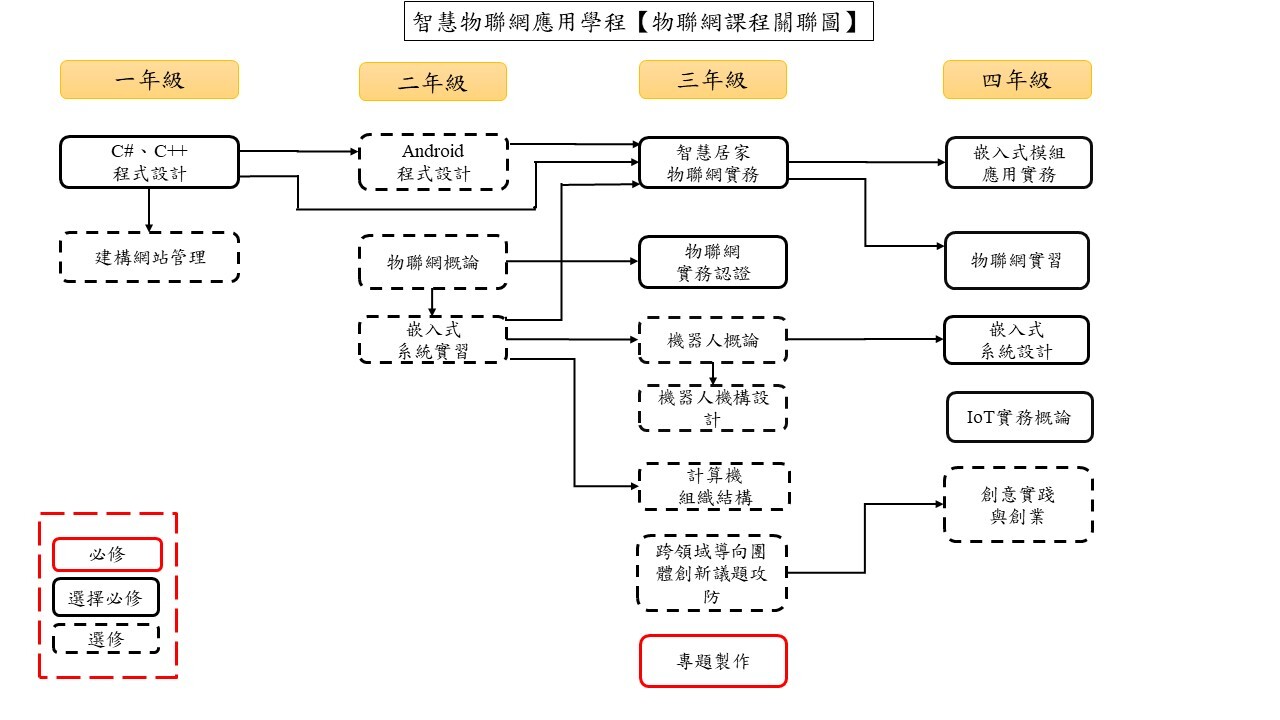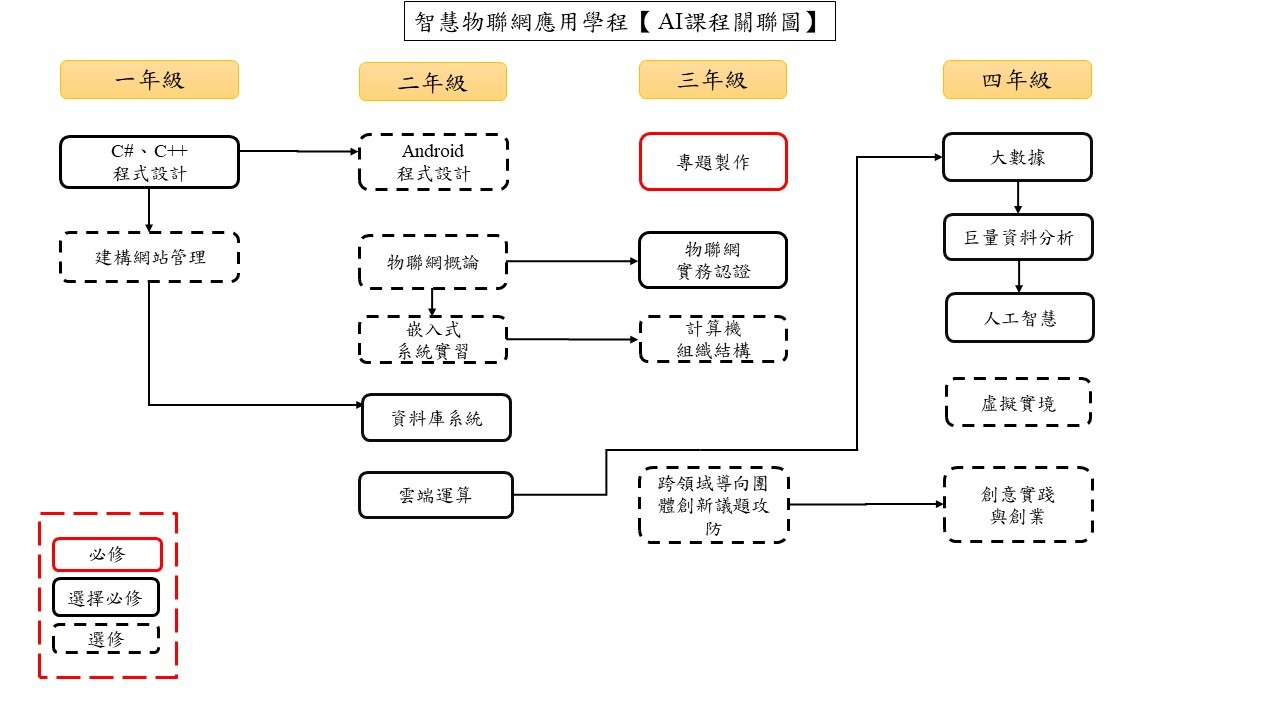Teaching Direction
Curriculum Planning
Our department offers both day and evening programs. The four-year day program started admitting students in the 91st academic year, and the evening program initially had one class for the two-year program, changing to one class for the four-year program in the 94th academic year. Additionally, a second class was added to the day program, and a weekend program for working professionals was established in the 98th academic year. The department emphasizes a practical approach with theory as a supplement. The curriculum is divided into two main branches: Computer Information and Network Technology. We offer a variety of elective courses to meet the diverse needs of students. The evening program curriculum is generally similar to the day program in terms of teaching objectives, but the content may differ. The evening program adopts a practical-guided teaching approach, allowing students to discuss their needs with teachers. The department holds annual curriculum forums, inviting representatives from academia, industry, alumni, current students, and all full-time faculty members to review and revise the curriculum.
Curriculum Structure
The department's curriculum is divided into basic professional requirements, core professional requirements, group professional courses, and advanced professional courses. Basic professional requirements are offered in the lower grades, with strict oversight to ensure that each student can successfully complete these courses. Core professional requirements are essential courses for completing the program and cultivating students' specialized skills. Upon completion, students can pursue careers in software and network-related fields. Advanced courses are designed to complement graduate studies or provide prerequisites for students interested in research, helping them find inspiration and develop innovative research skills. These courses offer opportunities for independent learning and critical thinking.
Teaching Objectives and Employment Analysis in the Department of Computer and Network Engineering
- Educate individuals with technical skills in computer information engineering and network communication technology.
- Emphasize advancement in the professional academic field.
- Focus on system integration.
- Cultivate students' deep professional knowledge and independent research capabilities.
Graduation Guide
- Certifications: Information Technician, Network Engineering Technician, CCNA, ITE, SCJP, ACA, iPAS IoT Engineer (basic and intermediate certifications), and other relevant certifications in information security.
- Graduate Programs: Computer Science, Information Engineering, Information Networks, and other related graduate programs.
- Employment Opportunities: Industries related to network engineering, programming, web design, information management systems, and communication and network management.
| Department's Teaching Development Goals | Industry Demand | Related Courses |
|---|---|---|
| Provide a learning environment for the construction of network systems. | Network and system construction | Website construction and management, network security technology, practical network planning, broadband network research, web design |
| Application of embedded systems. | Embedded system design and application | Embedded system design, microcomputer principles and application labs |
| Development of programming and application development skills. | Software programmer | JAVA programming, PHP programming, C++ programming, software design methods |
| Technical guidance for the development of network system applications. | Web design and network system programming | Window programming, advanced window programming, ASP web programming |
| Guidance on communication systems and network system technologies. | Wireless network mobile communication applications | Mobile communication networks, communication network performance analysis |
| Supervision platform for the application of databases in network systems. | Company information processing and data management | Database system management, multimedia database system management |
| Training for project implementation. | Newcomers who are willing and capable | Project implementation |

Chart Explanation:
Core competencies required for work (including network engineers, computer engineers, embedded system engineers, and system analysts) are:
General intelligence: General education courses (including basic language courses in Chinese and English, ethics, humanities, law, worldview, etc.)
Professional intelligence:
- Mathematics courses and basic science (including calculus, linear algebra, discrete mathematics, probability and statistics, general physics, Fourier analysis and transformation, computer introduction, internet and applications)
- Department of Information Engineering courses
- Network Engineering (yellow line)
Electives: Digital wireless communication and networks, e-commerce systemsWebsite construction and management, network engineering, information securityElectives: Internet application software development, database system management, PHP programming, JAVA programming
- Programming (dark red line)
Electives: Internet application software development, database system management, PHP programming, JAVA programmingC++ programming, window programming, data structures, software engineering, algorithms, assembly languageDigital logic design & lab, microcomputer application labElectives: Embedded system design, driver programming, introduction to digital signal processingOperating systems, computer organization and architecture, system programming, Linux system lab
- Embedded Systems (red line)
C++ programming, window programming, data structures, software engineering, algorithms, assembly languageDigital logic design & lab, microcomputer application labElectives: Embedded system design, driver programming, introduction to digital signal processing
- Operating Systems (green line)
Electives: Embedded system design, driver programming, introduction to digital signal processingOperating systems, computer organization and architecture, system programming, Linux system labElectives: Distributed systems
- Multimedia (blue line)
Electives: Internet application software development, database system management, PHP programming, JAVA programming
Electives: Introduction to digital image processing, multimedia application design - Artificial Intelligence (purple line)
C++ programming, window programming, data structures, software engineering, algorithms, assembly language
Electives: Introduction to artificial intelligence, neural networks
- Network Engineering (yellow line)
New in the 108th Academic Year: Smart Internet of Things Program
Curriculum Planning
-
IoT Application Engineer: Emphasizes embedded systems, wired/wireless communication devices, and innovative services for IoT applications.
-
Artificial Intelligence Engineer: Focuses on machine learning, language learning, audiovisual recognition, cloud platforms, and data analysis and algorithms.
-
Big Data Engineer: Involves data collection, data analysis, data warehousing, cloud storage technology, etc.
Refer to the following course maps in order.
1. IoT Embedded System Course Map

▲ Chart Explanation: Red solid line: Required, black solid line: Select required, black dashed line: Elective. Other course details are as follows:
First Year: C#, C++, website construction and management.
Second Year: Android programming, IoT introduction, embedded system lab, database system, cloud computing.
Third Year: IoT practical for smart homes, IoT practical certification, introduction to robotics, robot mechanism design, computer organization and structure, interdisciplinary team innovation topic attack and defense, project production.
Fourth Year: Embedded module application practice, IoT lab, embedded system design, introduction to IoT practice, creative practice and entrepreneurship.
2. IoT Technology Engineer Course Map

▲ Chart Explanation: Red solid line: Required, black solid line: Select required, black dashed line: Elective. Other course details are as follows:
First Year: C#, C++, website construction and management.
Second Year: Android programming, IoT introduction, embedded system lab, database system, cloud computing.
Third Year: Project production, IoT practical certification, computer organization and structure, interdisciplinary team innovation topic attack and defense.
Fourth Year: Big data, massive data analysis, artificial intelligence, virtual reality, creative practice and entrepreneurship.
3. Information Security Course Map

▲ Chart Explanation: Red solid line: Required, black solid line: Select required, black dashed line: Elective. Other course details are as follows:
First Year: C#, C++, website construction and management.
Second Year: Android programming, IoT introduction, embedded system lab, database system, cloud computing.
Third Year: Project production, IoT practical certification, computer organization and structure, interdisciplinary team innovation topic attack and defense.
Fourth Year: Introduction to digital image processing, IoT information security application, IoT lab, creative practice and entrepreneurship.

